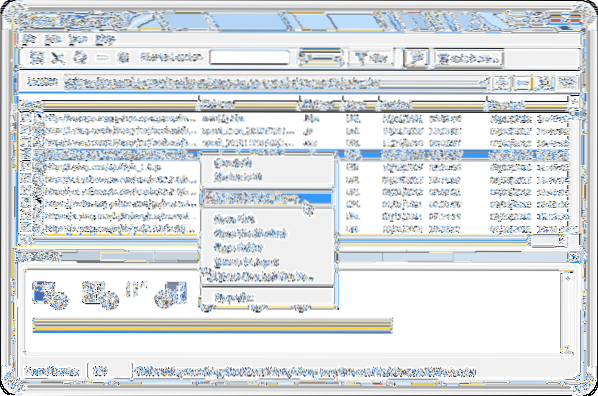- How do I view index dat files?
- Where are DAT files stored?
- Where the Temporary Internet files are stored?
- How do you view Internet Explorer history?
- What type of information is stored in the index DAT file?
- How do I find deleted history on Firefox?
- How do I convert a DAT file to MP4?
- Are .dat files dangerous?
- How do I decode a DAT file?
- Is it OK to delete temporary Internet files?
- Why can't I delete temporary Internet files?
- How are temporary Internet files stored on your computer?
How do I view index dat files?
Open any folder, click on Tools then Folder Options. Select View from the tab and uncheck "hide protected operating system files" and make sure "Show hidden files and folders is enabled". Now search for index. dat and Windows will display all the files in the search results.
Where are DAT files stored?
dat file located under the History folder. Cookies: index. dat contains a list of cookies placed on your computer by sites you visited. Cookies are small files placed on your computer by the websites you visited.
Where the Temporary Internet files are stored?
On Windows Vista and Windows 7 systems, the file is located in the “C:\Users\user\AppData\Local\Microsoft\Windows\Temporary Internet Files\Content.
How do you view Internet Explorer history?
View your browsing history and delete specific sites
- In Internet Explorer, select the Favorites button.
- Select the History tab, and choose how you want to view your history by selecting a filter from the menu. To delete specific sites, right-click a site from any of these lists and then select Delete.
What type of information is stored in the index DAT file?
dat file is a database file. It is a repository of information such as web URLs, search queries and recently opened files. Its purpose is to enable quick access to data used by Internet Explorer. For example, every web address visited is stored in the index.
How do I find deleted history on Firefox?
Open index. dat file within the reader > Click on the Firefox browsing history you want to restore > Click "Restore". Then you can open your Firefox browser to check all your restored history now. DNS cache only works to restore your deleted Firefox browsing history files when the computer is not shut down.
How do I convert a DAT file to MP4?
How to convert DAT file to MP4 using WinFF is nevertheless simple, see the guide below:
- Right-click the DAT file and delete the. DAT extension;
- Replace it with. ...
- Launch WinFF;
- Click the “Add” button and select the . ...
- Hit “Convert to” and select MP4;
- Choose the right video quality as well as settings;
- Click “Convert”.
Are .dat files dangerous?
The problem is that since . DAT files can be anything, they can also contain viruses. This also makes . DAT the go-to format for most hackers and spammers.
How do I decode a DAT file?
dat file in Windows using a text editor, right-click on the file you want to open, and select Open With. Select the text editor you want to use, and click OK. You'll be able to read the file's contents if it's a text-based . dat file.
Is it OK to delete temporary Internet files?
While temporary internet files can help you access websites faster, they take up a significant amount of space on your storage drive. By deleting these files, you can regain valuable storage space. If you're constantly trying to get more storage space, it might be time to upgrade to a larger SSD.
Why can't I delete temporary Internet files?
According to users, if you can't delete temporary files on Windows 10, you might want to try using Disk Cleanup tool. ... Press Windows Key + S and enter disk. Select Disk Cleanup from the menu. Make sure that your System drive, by default C, is selected and click OK.
How are temporary Internet files stored on your computer?
Each time a user visits a website using Microsoft Internet Explorer, files downloaded with each web page (including HTML and Javascript code) are saved to the Temporary Internet Files folder, creating a web cache of the web page on the local computer's hard disk drive, or other form of digital data storage.
 Naneedigital
Naneedigital


